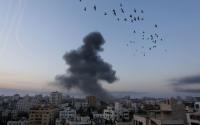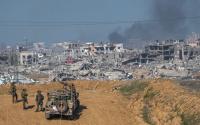26/6/2003Paul Rogers
At the end of the long cold war, in 1989, the United States suddenly became the world’s sole superpower. The then United States president, George Bush, quickly welcomed the onset of a ‘new world order’ modelled on a western-dominated liberal market economy backed by military power. Instead, the anticipated era of peace and stability was rapidly overturned by the 1991 Gulf war, followed by violent conflict in the Balkans, the Caucasus and Somalia, genocide in Rwanda and enduring Arab-Israeli and Indo-Pakistan tensions and conflicts.
Partly as a result, many aspects of the US armed forces were transformed during the 1990s. It was an incremental process but the overall aim was to tailor forces to protect American interests in a fractured and volatile world. Many of the cold war excesses were scaled down, including much (but certainly not all) of the nuclear arsenals, the tank armies in Europe and the US navy’s extensive anti-submarine forces. Overall, the number of people in the armed forces was cut back by about a third.
At the same time, other forces were maintained or even enhanced. The US navy kept almost all its aircraft carrier battle groups and added large numbers of land-attack cruise missiles to its capabilities, and the US Air Force went out of its way to develop long-range strike forces. Even the US army got in on the act with a greater commitment to special operations forces, and the US Marine Corps, with its unique ability to project power overseas, was preserved at close to its cold war level of force.
Yet it was not clear from the outset that these incremental changes amounted to an entirely new strategy, and there was sometimes a reluctance to commit troops to particular crises, an attitude accentuated by the experience in Somalia. Indeed, it was only with the unique combination of a neo-conservative security agenda and the aftermath of the 9/11 attacks that that strategy really took shape.
The new and aggressive US security doctrine, focused on pre-emption, is now becoming clear, and is being accompanied by rapid further changes in the make-up and basing of US forces. The irony, however, is that at the very time that the strategy is being developed and applied, circumstances are arising that make its viability highly doubtful.
A global ambition
The dominant US doctrine during the cold war was essentially one of containing the Soviet bloc, not least because the Soviet Union had formidable nuclear arsenals and its leaders believed for much of the time that they could “wait-out” the United States. At the same time, “containment” did not rule out aggressive policies, especially during the Ronald Reagan era of 1980-88. These included the widespread use of special forces in south-east Asia and Latin America, a maritime strategy in the 1980s that would take a war to the Soviet Union as soon as any conflict started, and a willingness to use nuclear weapons first.
These elements of cold war thinking have been hugely amplified by the neo-conservatives, with the Pentagon under Donald Rumsfeld and Paul Wolfowitz (and with the backing of the vice-president, Dick Cheney) making most of the running on foreign and security policy at the expense of the state department. The core of the strategy is the policy of pre-empting likely threats, whether they be “rogue” states such as Afghanistan and Iraq, or paramilitary organisations like al-Qaida and its associates.
The policy of “getting your retaliation in first” can take a number of forms, involving everything from targeted assassinations and clandestine operations through to full-scale pre-emptive war against states. Given the developments now being introduced in the nuclear weapons programme, it could even extend to the use of new generations of small nuclear weapons.
Overall, this policy requires quite different force dispositions from those of the cold war period, where the main concentrations were in Europe and elsewhere on the periphery of the Soviet bloc. Now, these dispositions stretch over more dispersed global zones of instability that are considered to include the northern parts of the Andes, North Africa, south-west and Central Asia, and parts of the western Pacific.
The United States nowhere faces a single, rival superpower; thus, it does not believe that there is any longer the requirement to have massive forces permanently based overseas. Instead, it is now implementing a plan for a few forward-operating military “hubs” – large facilities located on US territories such as Guam, and thoroughly reliable allies such as Britain.
Britain is actually important for three reasons. First, it has substantial existing facilities such as the air base complex at Lakenheath/Mildenhall in Suffolk, the recently activated stand-by base at Fairford in Gloucestershire and the huge surveillance centre at Menwith Hill in North Yorkshire. Second, it provides the US with the major support base at Diego Garcia in the Indian Ocean. Third, and most important of all, the British are regarded as the most acquiescent of allies – least likely to oppose the new US strategy.
Elsewhere, current locations such as the bases in Turkey or Saudi Arabia will be downgraded because they are in politically unreliable states, and the large forces in South Korea will be relocated away from the demilitarised zone to allow them to be more mobile and therefore available for regional contingencies. The large air force base at Ramstein in Germany will probably remain but many of the 60,000 Army troops will be withdrawn.
The overall plan is to open a number of bases in many parts of the world but they will not be like the huge facilities of the forty-year cold war. Instead, they will have small numbers of troops assigned permanently, but with the capability to take very large forces when required.
Many such bases already exist, including those in Kuwait, Oman, Qatar, the Emirates, Djibouti and Bahrain, but much of the concentration of forces in Germany may be redistributed to Bulgaria and Romania, closer to the Middle East. As ever, the Middle East remains key, both because of its immense oil reserves and also the US’s close connection with Israel. Whatever happens in Iraq, a permanent military presence there is as good as certain.
Further east, in Central Asia, the US’s temporary bases acquired at the time of the Afghan war in Uzbekistan, Tajikistan and Kyrgyzstan are likely to be made permanent, while recent reports of a major expansion programme at the base near Kandahar suggest a long-term presence in Afghanistan.
Another region, south-east Asia and the western Pacific, is viewed by the Pentagon as being of growing importance and there are reports that it may seek to re-establish a US military presence in the Philippines, if the political climate allows. It may also be seeking basing rights and staging areas in northern Australia, a country considered to be much more accommodating to US interests than others in the region.
In mapping this range of ambition, it would seem that the United States intends to maintain even larger forces overseas than it did at the height of the cold war, but this conclusion would be thoroughly misleading. The aim, rather, is to have the ability, when required, to operate in any of the zones of potential threat, taking vigorous pre-emptive action, mostly by using air power, the marines and special forces. This would enable the US to destroy any threats, whether from unacceptable regimes or paramilitary groups.
A project with unexpected results
The problems with such a strategy are many and diverse, but two particular ones are already emerging. The first is that it is based on the belief that there is only one way for the world to run and that that is the American way. The Project for the New American Century and similar neo-conservative groups are absolutely convinced that there is no alternative to the plans they have articulated. Yet their views are repeatedly rejected in country after country across the world. This generic opposition may take many forms, from the mild to the radical, but it means that everywhere, the environment for US efforts to enforce its global control is potentially dangerous.
The second problem stems from the first and arises when the United States uses its huge military power in what it considers to be its necessary security interests. The assumption is that a “threat” can be dealt with in a rapid military operation, to be replaced by the early imposition of a benign peace. Already, this assumption is revealed as deeply flawed.
Eighteen months after the defeat of the Taliban, Afghanistan is in deep disarray and the US will be obliged to maintain military forces on the ground, in a hostile environment, for years to come. In Iraq, violence and instability increases by the day, as US forces find it difficult, if not impossible, to control a resistance to occupation that is as deep-seated as it is unexpected.
With as many as a dozen attacks each day on US units, and with foreign attempts at reconstruction being repeatedly hindered by looting and violence, the prospect for an early draw-down of US forces is unlikely. The problems they face extend also to the British forces, and they will make other countries much more reluctant to commit their troops to the many insecure parts of Iraq.
The problem for the neo-conservative strategists, then, is that their belief that vigorous force will be followed by an immediate peace is wrong; tough military action in pursuit of its own security interests is much more likely to end up with the United States being directly involved on the ground, with its involvement extending to long-term counter-insurgency campaigns.
A number of articles in this series suggested that the war in Iraq might last right through the summer of 2003. Initially, this seemed mistaken, as formal resistance to the US invasion melted away in a matter of days. Now, less than two months after President Bush’s declaration that the war was at an end, these earlier assessments may turn out to be more accurate.
A key implication of all this is that the real significance of what is happening in Iraq, and indeed Afghanistan, may relate to the very viability of the pre-emptive strategy of US neo-conservatives. The United States has formulated a military strategy designed to “keep the violent peace” by the use of short sharp bursts of vigorous military force; but its likely result is to embroil US forces in dangerous, complicated and costly regional occupations – the very opposite of what was intended.






